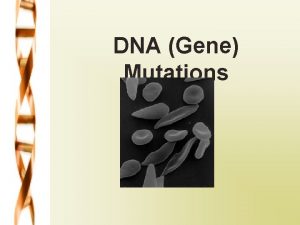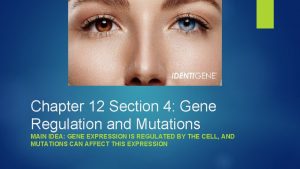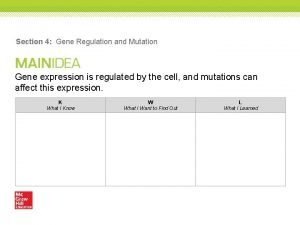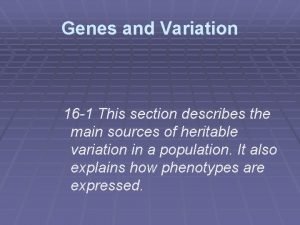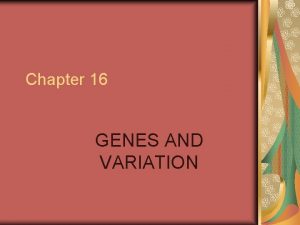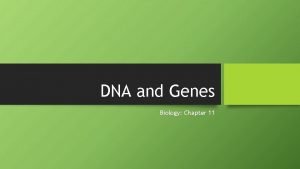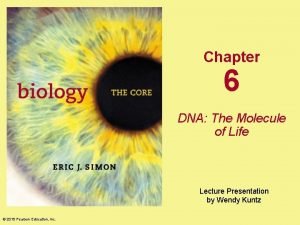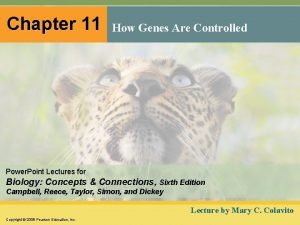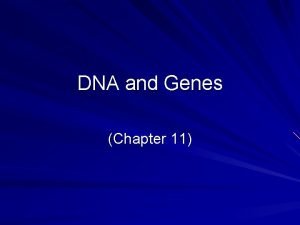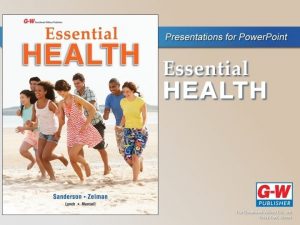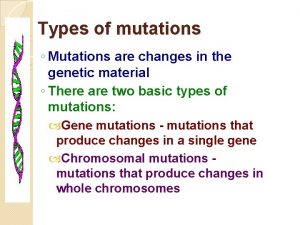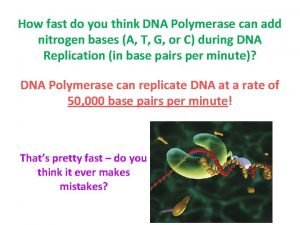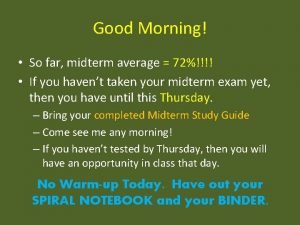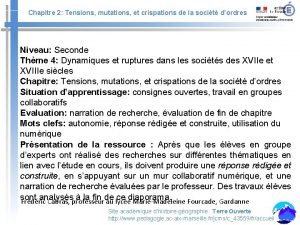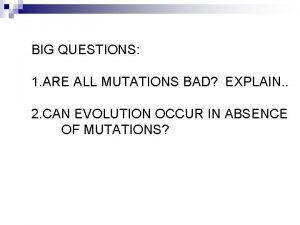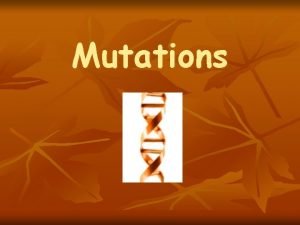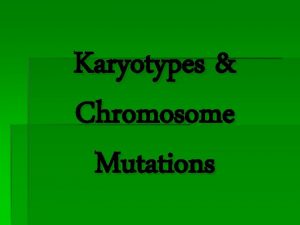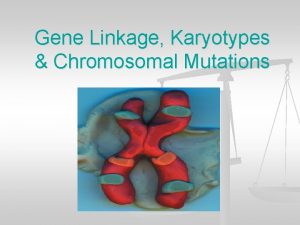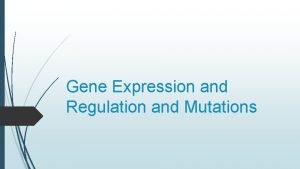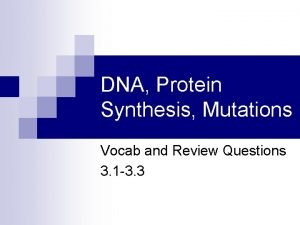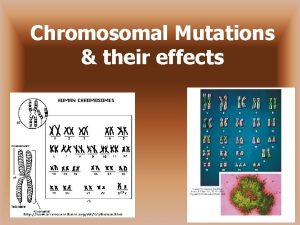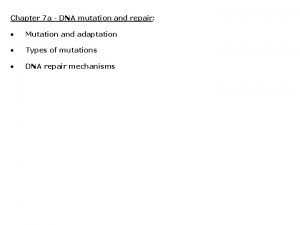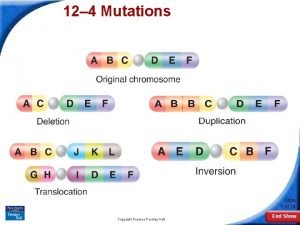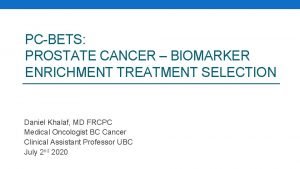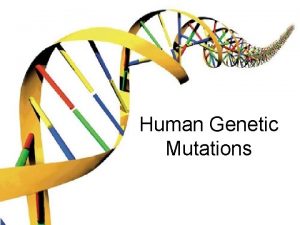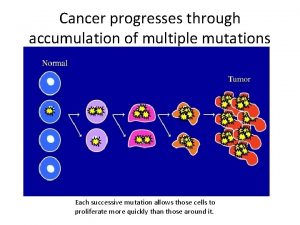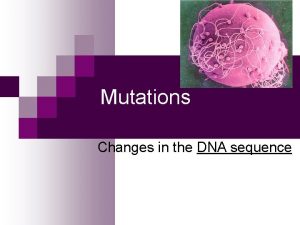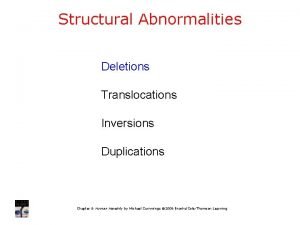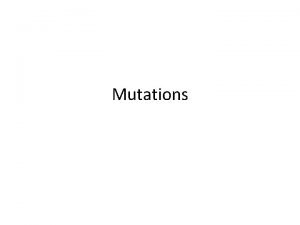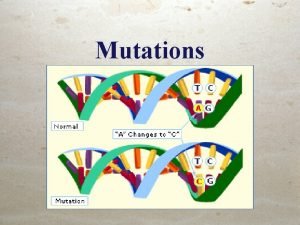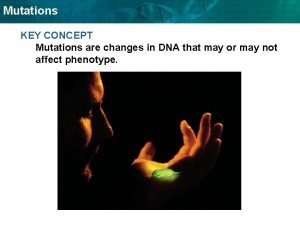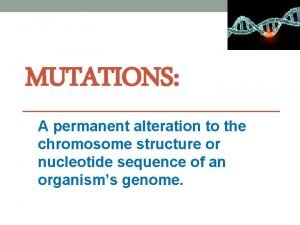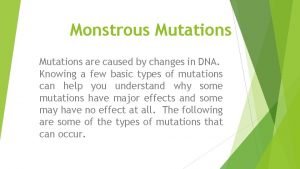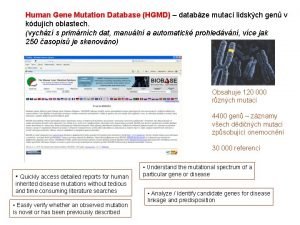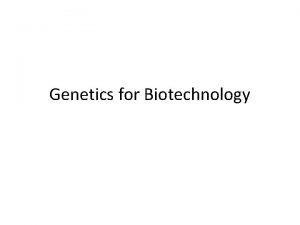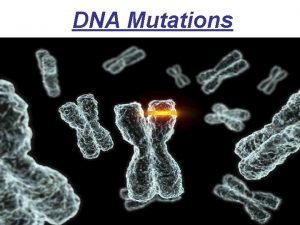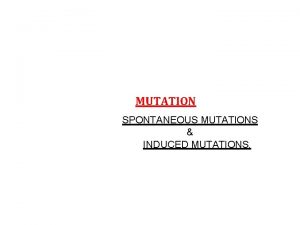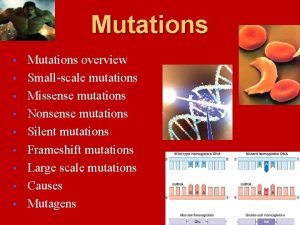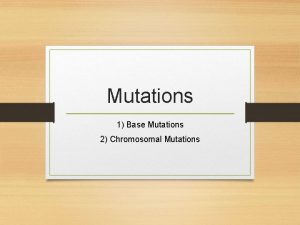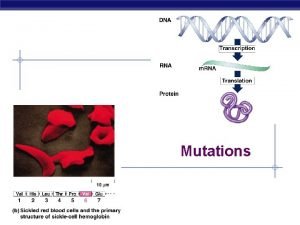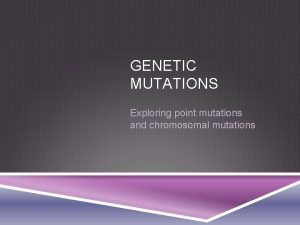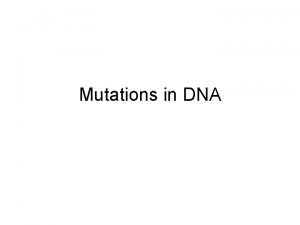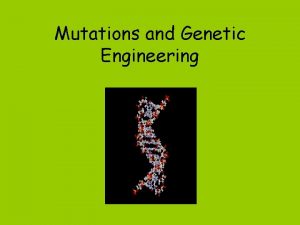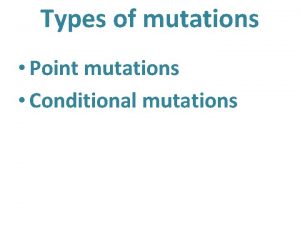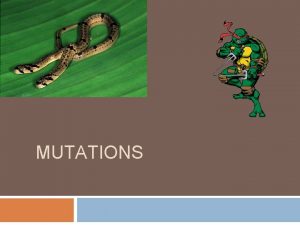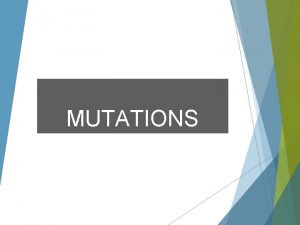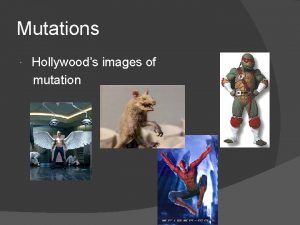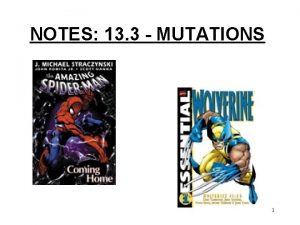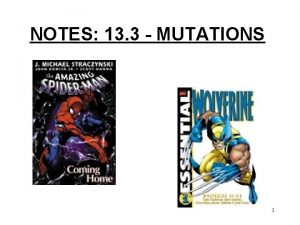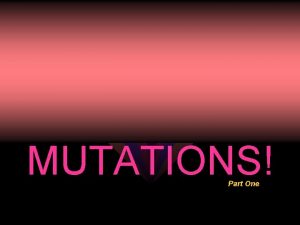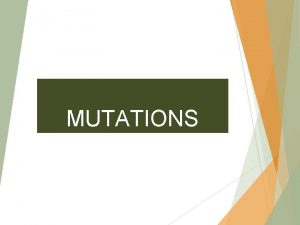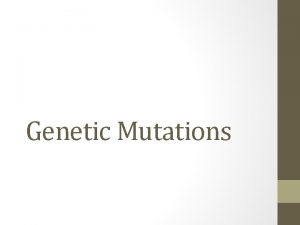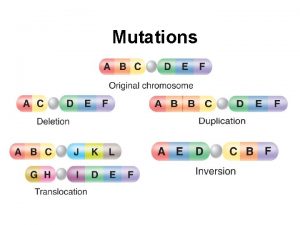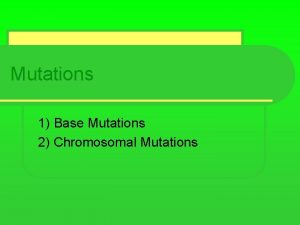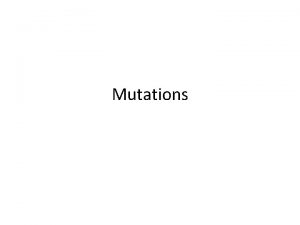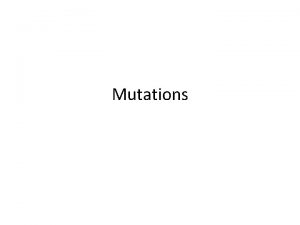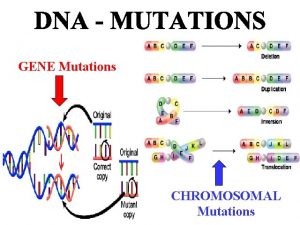Chapter 14 Genes In Action Section 1 Mutations












































![• Mutation Detection Original “given” DNA sequence GGCTACGAGCTTCGAAATTTGCCGATCCCA GGC[TACGAGCTTCGAAATTTGCCGATC]CCA AUG CUC GAA GCU • Mutation Detection Original “given” DNA sequence GGCTACGAGCTTCGAAATTTGCCGATCCCA GGC[TACGAGCTTCGAAATTTGCCGATC]CCA AUG CUC GAA GCU](https://slidetodoc.com/presentation_image/08173a7a7d8363799f708939ba6c6b0e/image-45.jpg)

![• Mutation Detection: Answers • • • 1. 2. Original DNA sequence GGC[TACGAGCTTCGAAATTTGCCGATC]CCA • Mutation Detection: Answers • • • 1. 2. Original DNA sequence GGC[TACGAGCTTCGAAATTTGCCGATC]CCA](https://slidetodoc.com/presentation_image/08173a7a7d8363799f708939ba6c6b0e/image-47.jpg)


- Slides: 49

Chapter 14. Genes In Action Section 1 Mutations

“Warm Up” • Define mutation. • What is a genetic mutant? • Remember, genes are incredibly precise DNA sequences. Recall how DNA is eventually translated into a protein. Discuss with your group what you think will happen if the sequence was somehow changed…



Mutants among us? • What do all of these comic book legends have in common? • Right. • They are all mutants!

Objectives: Mutations • Identify the primary mechanism for genetic change and differences among organisms. • List the kinds of mutations. • Describe the characteristics of each mutation. • Identify a mutation present in given DNA strands.

Vocabulary • • • Mutation Point mutation Insertion mutation Deletion mutation Silent mutation Missense mutation Frameshift mutation Nonsense mutation Duplication mutation Inversion mutation Translocation mutation Gene rearrangement

Section 14. 1 Exercise Write down the word CASH. How many more words can you make from that word by substituting, adding, or subtracting only one letter with a different letter? -Bash -Mash -Dash -Gash -Hash -Lash -Nash -Rash -Sash -Wash -Cast -Case -Casa -Cask -Casi -Crash -Clash -Ash • What if the directions asked you to change one letter out of these new words you’ve created… • Then asked you to do this again, and again, (maybe 10 times per new word). In addition, every once in awhile you were allowed to rearrange the letters. • How many new words do you think you could have? • If CASH was a gene, the new words you wrote would be mutations of CASH

The Role of Mutations • Mutation is a fundamental and inevitable aspect of heredity. • Without it we would never see genetic diversity. Mutat ions

2 Possible Outcomes of Changing DNA Sequences DNA C G A T G C C T C G A A G C C T C G A T C Changes in the DNA could lead to: Nothing (the change could result in the same amino acid Or The amino acid could be changed as well.

Mutations…Some Facts… • Can have no impact and may not be detectable. – These have no effect and are lost in the dominant – recessive allele interaction. – Remember, carriers don’t know they have the mutation & don’t display the phenotype. • A very small percentage can be good, or advantageous, and make life better, though. – These are how species evolve. • Most mutations that are detected are so because they are deleterious…meaning they result in something bad & many times death. • Do you know of any? • Does your family have any particular cases that may have some significance in this discussion?

An Affect of Mutation • Does anyone know what sickle cell anemia is? • Does anyone know of someone afflicted? • Can anyone describe the significant symptom of this disease?

Sickle cell anemia • These are RBC’s • They transport 02 in your bloodstream to cells that need it (for aerobic respiration) • The abnormal cell is a sickle cell. • It isn’t nearly as efficient in delivering oxygen throughout the body. • It is a co-dominant trait that was caused by a mutation.

Sickle Cell Anemia • Sickle Cell Anemia: – Can have troublesome side affects including: • • Bone & abdominal pain Fatigue Fever Delayed growth Blood clots in arteries Chest pain And possibly death…especially in low oxygen levels (at high altitudes).

A Strange Twist of Fate • Malaria is a parasitic disease that attacks RBC’s. • 40% of the world’s population has a high risk of contracting this (Asia, Africa, Central/South America). • Spread by infected mosquitoes, persons contracting malaria can come down with life threatening fevers, liver failure, and death. (#1 killer in 3 rd world youth) • Whereas children who inherit full-fledged sickle cell anemia (both mutated alleles = homozygous recessive) can have both sickle cell and malarial complications, those who inherit just one mutated allele (therefore partially affected…remember, it’s co-dominant) have a “survival advantage” to malaria and usually have no major sickle cell complications. • Most mutations are bad, and sickle cell anemia is, but sometimes mutations actually can have hidden benefits. Instituto Gulbenkian de Ciencia. "Mystery solved: How sickle hemoglobin protects against malaria. " Science. Daily, 29 Apr. 2011. Web. 31 Jul. 2012.

Tie To Prior Learning Complete the Punnett Square & Determine the % that will have the Sickle Cell Trait and who will be carriers. Two carriers of the sickle cell trait produce offspring. What % will be carriers? S s S SS Ss Full sickle cell ½ Sickle cell s Ss ss

Mutation: The Basis of Genetic Change • In genetics, a mutation is a change in the structure or amount of the genetic material of an organism. • What is this “genetic material”? • DNA • So what this means is that a mutation is a change in the structure or quantity of DNA in an organism. • A genetic mutant is an individual whose DNA or chromosomes differ from some original, previous, or normal state. • Don’t be alarmed…we are mutants of some sort.

• If any one of these combinations were to be changed by a mutagen the results could be devastating. What are the colored “sticks” representative of? Nitrogenous base paring…right?

It could change this…

To this

Mutation: The Basis of Genetic Change • Mutation has had a profound affect on evolution. • For the most part, genetic differences among organisms originated as some kind of genetic mutation. – This is responsible for what’s called speciation…or the different species on earth • As it is, every unique version of every gene (or every gene for that matter) began as a mutation of the original gene. – As an analogy, we all started as CASH…We are now all variations of this…Now we’re money.

The Original “CASH” • There is an interesting book from Dr. Richard Hawking titled “The Selfish Gene”. • In it he discusses the likely origination of nucleic acids found floating around in what’s called a “primordial soup”. • Imagine a gene the size of the word CASH floating around and mutations similar to the ones you performed in the opening exercise occurred over millions, possibly billions of years. • This may explain the initial variety of genetic material available to start the first organism. • What kind of organism could that be?

The Primordial Soup Theory • Imagine you were transported billions of years back into Earth's history. • Instead of sunny skies and clouds and trees and beaches and birds and beasts of the environment, evolutionists theorize that the Earth looked something like this, with ammonia, sulfur, methane, water, and amino acids…just the basic components of life around. • It’s from this that the first mutations are believed to have created life… if you believe in such.

Mutation

Several Kinds of Mutations • DNA and chromosomes are involved in many processes, so there are many kinds of mutations. • Most mutations involve a misplacement of a SINGLE nucleotide in a DNA segment. • A mutation may change the results of a gene (when the gene is translated and transcribed), but not all mutations do so. • Different kinds of mutations are recognized as either changes in DNA or changes in the results of genes.

Several Kinds of Mutations as Changes in DNA • During DNA replication, the wrong nucleotide may be paired or placed in a sequence. 1. Point mutation: • A point mutation is a change of a single nucleotide in a sequence from one kind of base to another. 2. Insertion or Deletion: • Rarely, errors in replication cause the insertion or deletion of one or more nucleotides in a sequence. • The CASH exercise we just performed illustrates what results from these types.

Several Kinds of Mutations as Changes in Results of Genes • Changes in a DNA sequence may affect the results of genes in many ways. 1. Silent Mutation: • A mutation is silent when it has no effect on a gene’s function. • Point mutations are often silent because the genetic code is redundant (some amino acids have multiple codons).

Several Kinds of Mutations as Changes in Results of Genes 2. Missence (Replacement) Mutation: • Results when a codon is changed (bases are switched) such that the new codon codes for a different amino acid. 3. Frameshift: • The reading frame of a sequence depends on the starting point for reading (the start codon). • This sets up the rest if the gene’s codons. • An insertion or deletion can shift the reading frame, or cause a frameshift. • In frameshift mutations, the remaining sequence may be “read” as different codons.

Several Kinds of Mutations as Changes in Results of Genes 4. Nonsense: • Results when an internal codon is changed to a “stop” signal. • In this case, the resulting string of amino acids may be cut short, and the protein may fail to function. 5. More or fewer Amino acids: • If an insertion or deletion is a multiple of 3, the reading frame will be preserved. It causes the resulting protein to have more or less amino acids than originally. • An insertion or deletion of many codons is likely to disrupt the resulting protein’s structure and function.


Chromosomal Mutations • In eukaryotic cells, the process of meiosis creates the chance of mutations at the chromosomal level. • Recall that during meiosis, chromosomes pair up and may undergo crossover. Usually, the result is an equal exchange of alleles between homologous chromosomes. • Sometimes there is an unequal exchange that can cause chromosomal mutations. • There are 5 main types of chromosomal mutations.

Chromosomal Mutations 1. A deletion occurs when a piece of a chromosome is lost. At the end of meiosis, one of the cells will lack the genes from that missing piece. Such deletions are usually harmful. 2. A duplication occurs when a piece remains attached to its homologous chromosome after meiosis. One chromosome will then carry both alleles for each of the genes in that piece.

Chromosomal Mutations 3. An inversion occurs when a piece reattaches to its original chromosome, but in a reverse direction. 4. A translocation occurs when a chromosome piece ends up in a completely different, non-homologous chromosome. 5. A gene rearrangement can move an entire gene to a new location. Such a chromosomal mutation is likely to disrupt the gene’s function in other ways.

Chromosomal Mutations

What is the WORST? No affect • Most proteins can Little affect function normally Major Affects with only one amino acid change. • The more amino acids changed, the more of an affect. • What is the worst? • Tough to say as each scenario is unique, however, mutations that dramatically alter the protein will have severe affects on protein effectiveness.

What Causes Mutations? • A variety of factors influence changes in DNA. 1. Problems in Meiosis 1. 2. Transposable elements. 1. 3. Jumping Genes that move from chromosome to chromosome. Spontaneous errors in replication. 1. 4. Nondisjunction & Polyploidy Usually corrected by DNA Polymerase but can, at times, be passed down to next-generation cells. If this happens in gametes, children can be affected with gene-based abnormalities. Harmful environmental agents. 1. 2. 3. Ionizing radiation: X-rays and gamma rays can break chromosome pieces or cause free-radicals (highly reactive hydroxide ions that damage DNA) Non-ionizing Radiation: cause adjacent thymine bases to bond, kinking DNA Natural or Synthetic Chemicals: a. k. a. Carcinogens

Transposable Elements Nobel Prize winner in 1983, Barbara Mc. Clintock discovered that certain genes can slip from one place on a chromosome to another, sometimes disrupting the target site.

Errors In Replication

Environmental Influences • Ionizing Radiation: • Non-Ionizing Radiation: • Carcinogens: http: //www. cancer. org/cancercauses/othercarcinogens/gener alinformationaboutcarcinogens/known-and-probable-humancarcinogens

What Kind of Mutation Illustrated? In your groups, first identify the problem, make the m. RNA, the amino acids, then name the type of mutation. You have 5 minutes for discussion and conclusions. Normal = Wildtype Gene TACGGTAGC Problem TACGTTAGC Problem TACGGAAGC Problem TACCGGTAGC

Each of the following is a modification of the sentence THECATATETHERAT 1. THERATATETHECAT 2. THEKATATETHERAT 3. THETACATETHERAT 4. THECATARETHERAT 5. THECATATTHERATS 6. HECATATETHERATS Which one(s) is/are: 1. A FRAMESHIFT mutation? 2. A SILENT mutation? 3. A DELETION mutation? 4. An INVERSION mutation? 5. A POINT mutation?

Mutation Detection (25 pts) • You, as a microbiologist or a geneticist, have the ability to look at the sequence of an organism. You would do so to detect differences between “normal” DNA and mutations. • Your research objective today is to study the following mutant DNA sequences to detect the type of mutation and where it takes place. The mutations are changes in the DNA that result in the changes of their genes (not their pants). First study the given DNA sequence. Then you will need to determine the reading frame (the active gene within) and transcribe it into m. RNA (remember, the m. RNA has the codons). Translate the m. RNA into a polypeptide so you know the original gene product. Next determine what type of mutation the mutants are by comparing the original DNA strand the mutant DNA. You will need to use a codon chart (pg 307) for help. MIND THE START & STOP CODONS!!!

Mutation Detection • Original “given” DNA sequence GGCTACGAGCTTCGAAATTTGCCGATCCCA 1. (5 pts) First identify the start sequence in the DNA above. Transcribe the DNA into m. RNA & group into 3’s until you reach the stop codon. Use the codon chart on pg 307 to identify any changes in amino acids. Translate the m. RNA into a polypeptide chain. Use this to compare to the mutants. 2. Mutant one: Mutation type? (3) Where? (1) Give support! (1) GGCTACGAGCTTCGAAAATTTGCCGATCCCA

Gene TAC m. RNA AUG A. A. MET • GAG CTT CGA AAT TTG CCG ATC CUC GAA GCI UUA AAC GGC STOP LEU GLU ALA LEU ASN GLY NONE Mutation Detection Original “given” DNA sequence GGC[TAC]GAGCTTCGAAATTTGCCGATCCCA m. RNA: AUG CUC GAA GCU UUA AAC GGC Stop Polypeptide: Met Leu Glu Ala Leu As. P Gly Stop 1. (5 pts) First identify the start sequence in the DNA above. Transcribe the DNA into m. RNA & group into 3’s until you reach the stop codon. Use the codon chart on pg 307 to identify any changes in amino acids. Translate the m. RNA into a polypeptide chain. Use this to compare to the mutants. 2. Mutant one: Mutation type? (3) Where? (1) Give support! (1) GGCTACGAGCTTCGAAAATTTGCCGATCCCA Mutant one: FRAMESHIFT the original reading frame is affected GGCTACGAGCTTCGAAAATTTGCCGATCCCA… AUG CUC GAA GCU UU[U] AAA CGG CUA GGG U m. RNA: AUG CUC GAA GCU UUA AAC GGC Stop ORIGINAL Polypeptide: Met Leu Glu Ala Leu Asp Gly Stop ORIGINAL New: Met Leu Glu Ala Phe Lys Arg Leu Gly… The new polypeptide will be MUCH bigger than the original creating a very new gene product…one that most likely won’t be a useable protein.
![Mutation Detection Original given DNA sequence GGCTACGAGCTTCGAAATTTGCCGATCCCA GGCTACGAGCTTCGAAATTTGCCGATCCCA AUG CUC GAA GCU • Mutation Detection Original “given” DNA sequence GGCTACGAGCTTCGAAATTTGCCGATCCCA GGC[TACGAGCTTCGAAATTTGCCGATC]CCA AUG CUC GAA GCU](https://slidetodoc.com/presentation_image/08173a7a7d8363799f708939ba6c6b0e/image-45.jpg)
• Mutation Detection Original “given” DNA sequence GGCTACGAGCTTCGAAATTTGCCGATCCCA GGC[TACGAGCTTCGAAATTTGCCGATC]CCA AUG CUC GAA GCU UUA AAC GGC Stop 1. (5 pts) First identify the start sequence in the DNA above. Transcribe the DNA into m. RNA & group into 3’s until you reach the stop codon. Use the codon chart on pg 307 to identify any changes in amino acids. Translate the m. RNA into a polypeptide chain. Use this to compare to the mutants. 2. Mutant one: Mutation type? (3) Where? (1) Give support! (what is the change in the amino acid sequence… 1) GGCTACGAGCTTCGAAAATTTGCCGATCCCA Homework (5 points each) 1. Mutant 2: Mutation type? Where? Give support! GGCTACGAGCTTCGAACTTTGCCGATCCCA 2. Mutant 3: Mutation type? Where? Give support! GGCTACGAGCCTCGAAATTTGCCGATCCCA 3. Mutant 4: Mutation type? Where? Give support! GGCTACGACCTTCGAAATTTGCCGATCCCA

Summary: Please Write The… • 2 types of DNA mutations • 5 types of gene mutations • 5 types of chromosome mutations
![Mutation Detection Answers 1 2 Original DNA sequence GGCTACGAGCTTCGAAATTTGCCGATCCCA • Mutation Detection: Answers • • • 1. 2. Original DNA sequence GGC[TACGAGCTTCGAAATTTGCCGATC]CCA](https://slidetodoc.com/presentation_image/08173a7a7d8363799f708939ba6c6b0e/image-47.jpg)
• Mutation Detection: Answers • • • 1. 2. Original DNA sequence GGC[TACGAGCTTCGAAATTTGCCGATC]CCA m. RNA: AUG – CUC – GAA – GCU – UUA – AAC – GGC – UAG A. A. s MET – LEU – GLU – ALA - LEU – ASP – GLY – STOP Identify the reading frame by transcribing the DNA & identifying the start codon. Then group the codons in 3’s until you reach the stop codon. Mutant one: FRAMESHIFT the original reading frame is affected GGCTACGAGCTTCGAAAATTTGCCGATCCCA… UUU – AAA – CGG – CUA – GGG MET – LEU – GLU – ALA – PHE – LYS – ARG – LEU – GLY Homework 1. Mutant 2: NONSENSE an internal stop codon is inserted GGCTACGAGCTTCGAACTTTGCCGATCCCA MET – LEU – GLU – ALA – STOP 2. Mutant 3: MISSENSE a new amino acid is made with the mutation GGCTACGAGCCTCGAAATTTGCCGATCCCA MET – LEU – GLU – ALA – GLU GLY 3. Mutant 4: SILENT the gene isn’t affected as GAC & GAG both code for the same amino acid GGCTACGACCTTCGAAATTTGCCGATCCCA MET – LEU – GLU – ALA – LEU

Assignment Rubric Number of points 5 4 3 2 1 Correctly identifies the mutation (3 points). Correctly identifies the mutation location. Correctly gives support. Correctly identifies the mutation (3) and one of the following: identifies the mutation location (1) or gives correct support (1). Correctly identifies the mutation (3) OR identifies the mutation location AND gives correct support. Correctly identifies the location of the mutation (1) AND gives support (1). Identifies the location of the mutation (1) OR gives correct support (1). Assignment is worth a total of 25 points are awarded per question. The first question the student must identify the start codon (1). Transcribe the DNA into m. RNA (1) until they reach the stop codon (1). Then translate the m. RNA into a polypeptide chain (1).

Group “Think-Pair-Share” What causes mutations? • (1 min) First, think about what things in the environment that could cause mutations. List 5 possibilities. • (1 min) Next, share with your partner and come up with a list of 5 things that could cause mutations. • (1 min) Finally, share with your group and come up with a consensus list of 5 possibilities.
 Causes of mutation
Causes of mutation Linked genes and unlinked genes
Linked genes and unlinked genes Genepattern
Genepattern Polygenic inheritance
Polygenic inheritance Section 4 gene regulation and mutation
Section 4 gene regulation and mutation Section 4 gene regulation and mutations
Section 4 gene regulation and mutations Chapter 14 lesson 4 mutations
Chapter 14 lesson 4 mutations Stabilizing selection human birth weight
Stabilizing selection human birth weight This section describes
This section describes Evolution of populations section 16-1 genes and variation
Evolution of populations section 16-1 genes and variation Chapter 16 evolution of populations
Chapter 16 evolution of populations Section 16-1 genes and variation
Section 16-1 genes and variation Chapter 11 dna and genes
Chapter 11 dna and genes The age of genes chapter 6
The age of genes chapter 6 Chapter 11 how genes are controlled reading guide
Chapter 11 how genes are controlled reading guide Dna and genes chapter 11
Dna and genes chapter 11 Dna and genes chapter 11
Dna and genes chapter 11 Chapter 2 risk factors behavior genes environment
Chapter 2 risk factors behavior genes environment What are some types of chromosomal mutations?
What are some types of chromosomal mutations? What are some neutral mutations
What are some neutral mutations Amoeba sisters mutations worksheet
Amoeba sisters mutations worksheet Tensions mutations et crispations de la société d'ordres
Tensions mutations et crispations de la société d'ordres Are all mutations bad? *
Are all mutations bad? * What is a beneficial mutation in humans
What is a beneficial mutation in humans 4 steps of protein synthesis
4 steps of protein synthesis Slidetodoc.com
Slidetodoc.com Karyotype mutations
Karyotype mutations Types of mutations
Types of mutations Protein synthesis and mutations
Protein synthesis and mutations Protein synthesis and mutations
Protein synthesis and mutations Karyotype mutations
Karyotype mutations Mutation and adaptation
Mutation and adaptation 12-4 mutations
12-4 mutations Cancer mutations
Cancer mutations Two types of point mutation
Two types of point mutation Cancer mutations
Cancer mutations Cancer mutations
Cancer mutations Dna types of mutations
Dna types of mutations Forward mutation
Forward mutation Duplication chromosomique
Duplication chromosomique Chromosome mutation
Chromosome mutation A mutation is any mistake or change in the
A mutation is any mistake or change in the Gene mutations
Gene mutations Permanent
Permanent Monstrous mutations
Monstrous mutations Point mutations
Point mutations Databze
Databze Somatic mutations
Somatic mutations Dna rna protein central dogma
Dna rna protein central dogma Types of mutation
Types of mutation
